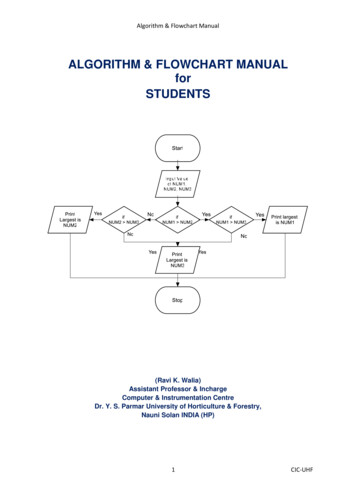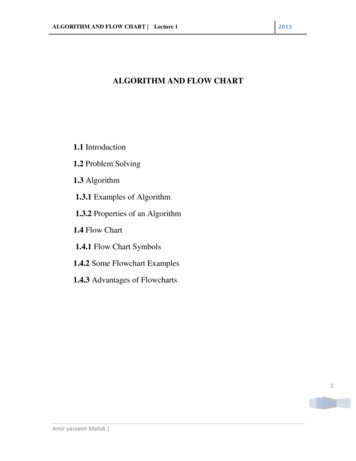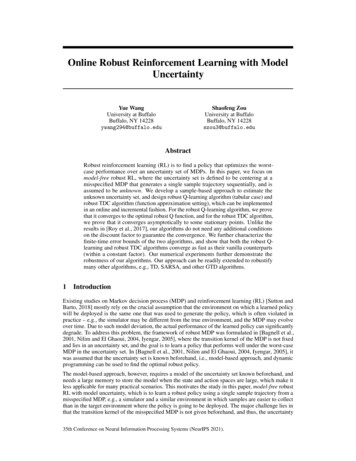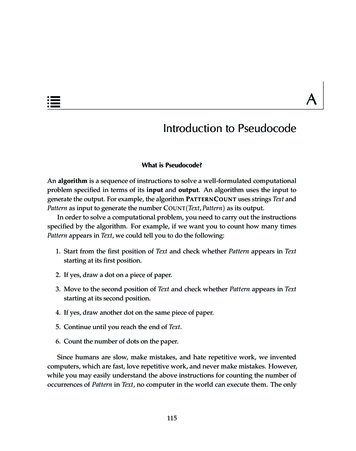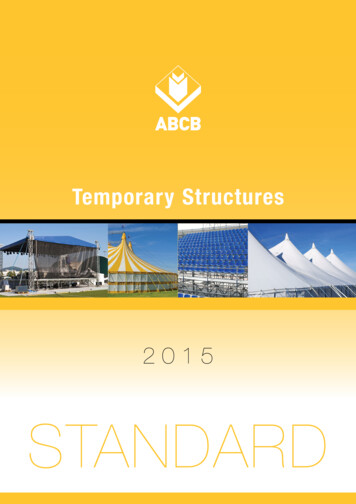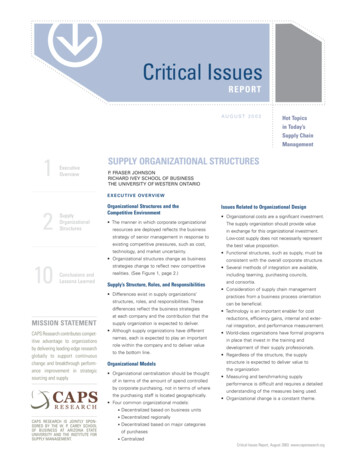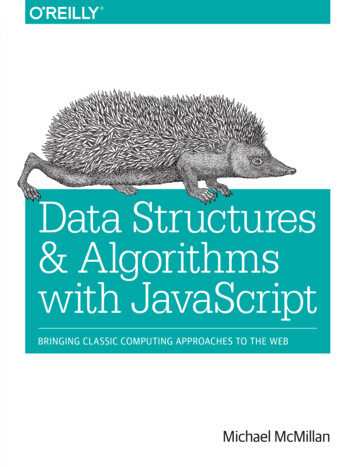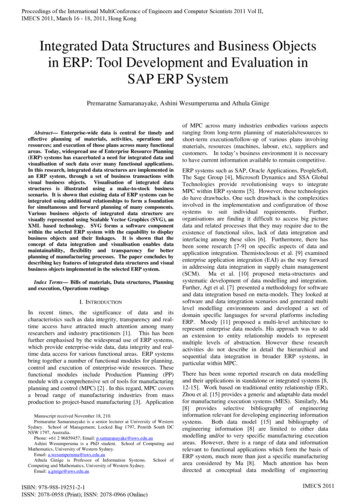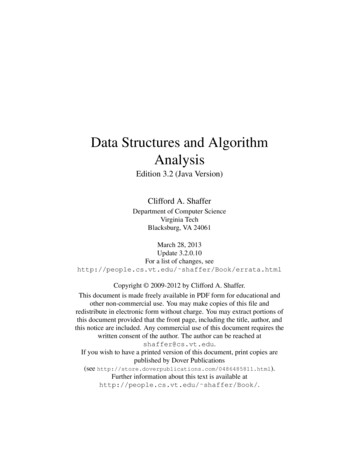
Transcription
Data Structures and AlgorithmAnalysisEdition 3.2 (Java Version)Clifford A. ShafferDepartment of Computer ScienceVirginia TechBlacksburg, VA 24061March 28, 2013Update 3.2.0.10For a list of changes, seehttp://people.cs.vt.edu/ shaffer/Book/errata.htmlCopyright 2009-2012 by Clifford A. Shaffer.This document is made freely available in PDF form for educational andother non-commercial use. You may make copies of this file andredistribute in electronic form without charge. You may extract portions ofthis document provided that the front page, including the title, author, andthis notice are included. Any commercial use of this document requires thewritten consent of the author. The author can be reached atshaffer@cs.vt.edu.If you wish to have a printed version of this document, print copies arepublished by Dover Publications(see ).Further information about this text is available athttp://people.cs.vt.edu/ shaffer/Book/.
ContentsPrefacexiiiIPreliminaries11Data Structures and Algorithms1.1 A Philosophy of Data Structures1.1.1 The Need for Data Structures1.1.2 Costs and Benefits1.2 Abstract Data Types and Data Structures1.3 Design Patterns1.3.1 Flyweight1.3.2 Visitor1.3.3 Composite1.3.4 Strategy1.4 Problems, Algorithms, and Programs1.5 Further Reading1.6 Exercises3446812131314151618202Mathematical Preliminaries2.1 Sets and Relations2.2 Miscellaneous Notation2.3 Logarithms2.4 Summations and Recurrences2.5 Recursion2.6 Mathematical Proof Techniques23232729303436iii
ivContents2.72.82.93II42.6.1 Direct Proof2.6.2 Proof by Contradiction2.6.3 Proof by Mathematical InductionEstimationFurther ReadingExercisesAlgorithm Analysis3.1 Introduction3.2 Best, Worst, and Average Cases3.3 A Faster Computer, or a Faster Algorithm?3.4 Asymptotic Analysis3.4.1 Upper Bounds3.4.2 Lower Bounds3.4.3 Θ Notation3.4.4 Simplifying Rules3.4.5 Classifying Functions3.5 Calculating the Running Time for a Program3.6 Analyzing Problems3.7 Common Misunderstandings3.8 Multiple Parameters3.9 Space Bounds3.10 Speeding Up Your Programs3.11 Empirical Analysis3.12 Further Reading3.13 Exercises3.14 ProjectsFundamental Data StructuresLists, Stacks, and Queues4.1 Lists4.1.1 Array-Based List Implementation4.1.2 Linked Lists4.1.3 Comparison of List 4757778808384858991939497100108
vContents4.24.34.44.54.64.74.1.4 Element Implementations4.1.5 Doubly Linked ListsStacks4.2.1 Array-Based Stacks4.2.2 Linked Stacks4.2.3 Comparison of Array-Based and Linked Stacks4.2.4 Implementing RecursionQueues4.3.1 Array-Based Queues4.3.2 Linked Queues4.3.3 Comparison of Array-Based and Linked QueuesDictionariesFurther 51281311311381381415Binary Trees5.1 Definitions and Properties5.1.1 The Full Binary Tree Theorem5.1.2 A Binary Tree Node ADT5.2 Binary Tree Traversals5.3 Binary Tree Node Implementations5.3.1 Pointer-Based Node Implementations5.3.2 Space Requirements5.3.3 Array Implementation for Complete Binary Trees5.4 Binary Search Trees5.5 Heaps and Priority Queues5.6 Huffman Coding Trees5.6.1 Building Huffman Coding Trees5.6.2 Assigning and Using Huffman Codes5.6.3 Search in Huffman Trees5.7 Further Reading5.8 Exercises5.9 1881881891926Non-Binary Trees195
viContents6.1III7General Tree Definitions and Terminology1956.1.1An ADT for General Tree Nodes1966.1.2General Tree Traversals1976.2The Parent Pointer Implementation1996.3General Tree Implementations2066.3.1List of Children2066.3.2The Left-Child/Right-Sibling Implementation2066.3.3Dynamic Node Implementations2076.3.4Dynamic “Left-Child/Right-Sibling” Implementation2106.4K-ary Trees2106.5Sequential Tree Implementations2126.6Further Reading2156.7Exercises2156.8Projects218Sorting and Searching221Internal Sorting2237.12247.2Sorting Terminology and NotationThreeΘ(n2 )Sorting Algorithms2257.2.1Insertion Sort2257.2.2Bubble Sort2277.2.3Selection Sort2297.2.4The Cost of Exchange rt2367.6Heapsort2437.7Binsort and Radix Sort2447.8An Empirical Comparison of Sorting Algorithms2517.9Lower Bounds for Sorting2537.10 Further Reading2577.11 Exercises2577.12 Projects261
Contentsvii8File Processing and External Sorting8.1 Primary versus Secondary Storage8.2 Disk Drives8.2.1 Disk Drive Architecture8.2.2 Disk Access Costs8.3 Buffers and Buffer Pools8.4 The Programmer’s View of Files8.5 External Sorting8.5.1 Simple Approaches to External Sorting8.5.2 Replacement Selection8.5.3 Multiway Merging8.6 Further Reading8.7 Exercises8.8 9Searching9.1 Searching Unsorted and Sorted Arrays9.2 Self-Organizing Lists9.3 Bit Vectors for Representing Sets9.4 Hashing9.4.1 Hash Functions9.4.2 Open Hashing9.4.3 Closed Hashing9.4.4 Analysis of Closed Hashing9.4.5 Deletion9.5 Further Reading9.6 Exercises9.7 Projects30130230731331431532032133133433533633810 Indexing10.1 Linear Indexing10.2 ISAM10.3 Tree-based Indexing10.4 2-3 Trees10.5 B-Trees10.5.1 B -Trees341343346348350355358
viiiContents10.5.2 B-Tree Analysis10.6 Further Reading10.7 Exercises10.8 ProjectsIVAdvanced Data Structures36436536536736911 Graphs11.1 Terminology and Representations11.2 Graph Implementations11.3 Graph Traversals11.3.1 Depth-First Search11.3.2 Breadth-First Search11.3.3 Topological Sort11.4 Shortest-Paths Problems11.4.1 Single-Source Shortest Paths11.5 Minimum-Cost Spanning Trees11.5.1 Prim’s Algorithm11.5.2 Kruskal’s Algorithm11.6 Further Reading11.7 Exercises11.8 40212 Lists and Arrays Revisited12.1 Multilists12.2 Matrix Representations12.3 Memory Management12.3.1 Dynamic Storage Allocation12.3.2 Failure Policies and Garbage Collection12.4 Further Reading12.5 Exercises12.6 Projects40540540841241442142542642713 Advanced Tree Structures13.1 Tries429429
Contents13.2 Balanced Trees13.2.1 The AVL Tree13.2.2 The Splay Tree13.3 Spatial Data Structures13.3.1 The K-D Tree13.3.2 The PR quadtree13.3.3 Other Point Data Structures13.3.4 Other Spatial Data Structures13.4 Further Reading13.5 Exercises13.6 ProjectsVTheory of Algorithmsix43443543744044244745145345345445545914 Analysis Techniques14.1 Summation Techniques14.2 Recurrence Relations14.2.1 Estimating Upper and Lower Bounds14.2.2 Expanding Recurrences14.2.3 Divide and Conquer Recurrences14.2.4 Average-Case Analysis of Quicksort14.3 Amortized Analysis14.4 Further Reading14.5 Exercises14.6 Projects46146246746747047247447647947948315 Lower Bounds15.1 Introduction to Lower Bounds Proofs15.2 Lower Bounds on Searching Lists15.2.1 Searching in Unsorted Lists15.2.2 Searching in Sorted Lists15.3 Finding the Maximum Value15.4 Adversarial Lower Bounds Proofs15.5 State Space Lower Bounds Proofs15.6 Finding the ith Best Element485486488488490491493496499
xContents15.7 Optimal Sorting15.8 Further Reading15.9 Exercises15.10Projects50150450450716 Patterns of Algorithms16.1 Dynamic Programming16.1.1 The Knapsack Problem16.1.2 All-Pairs Shortest Paths16.2 Randomized Algorithms16.2.1 Randomized algorithms for finding large values16.2.2 Skip Lists16.3 Numerical Algorithms16.3.1 Exponentiation16.3.2 Largest Common Factor16.3.3 Matrix Multiplication16.3.4 Random Numbers16.3.5 The Fast Fourier Transform16.4 Further Reading16.5 Exercises16.6 53253317 Limits to Computation17.1 Reductions17.2 Hard Problems17.2.1 The Theory of N P-Completeness17.2.2 N P-Completeness Proofs17.2.3 Coping with N P-Complete Problems17.3 Impossible Problems17.3.1 Uncountability17.3.2 The Halting Problem Is Unsolvable17.4 Further Reading17.5 Exercises17.6 graphy567
ContentsIndexxi573
PrefaceWe study data structures so that we can learn to write more efficient programs.But why must programs be efficient when new computers are faster every year?The reason is that our ambitions grow with our capabilities. Instead of renderingefficiency needs obsolete, the modern revolution in computing power and storagecapability merely raises the efficiency stakes as we attempt more complex tasks.The quest for program efficiency need not and should not conflict with sounddesign and clear coding. Creating efficient programs has little to do with “programming tricks” but rather is based on good organization of information and good algorithms. A programmer who has not mastered the basic principles of clear designis not likely to write efficient programs. Conversely, concerns related to development costs and maintainability should not be used as an excuse to justify inefficientperformance. Generality in design can and should be achieved without sacrificingperformance, but this can only be done if the designer understands how to measureperformance and does so as an integral part of the design and implementation process. Most computer science curricula recognize that good programming skills begin with a strong emphasis on fundamental software engineering principles. Then,once a programmer has learned the principles of clear program design and implementation, the next step is to study the effects of data organization and algorithmson program efficiency.Approach: This book describes many techniques for representing data. Thesetechniques are presented within the context of the following principles:1. Each data structure and each algorithm has costs and benefits. Practitionersneed a thorough understanding of how to assess costs and benefits to be ableto adapt to new design challenges. This requires an understanding of theprinciples of algorithm analysis, and also an appreciation for the significanteffects of the physical medium employed (e.g., data stored on disk versusmain memory).2. Related to costs and benefits is the notion of tradeoffs. For example, it is quitecommon to reduce time requirements at the expense of an increase in spacerequirements, or vice versa. Programmers face tradeoff issues regularly in allxiii
xivPrefacephases of software design and implementation, so the concept must becomedeeply ingrained.3. Programmers should know enough about common practice to avoid reinventing the wheel. Thus, programmers need to learn the commonly useddata structures, their related algorithms, and the most frequently encountereddesign patterns found in programming.4. Data structures follow needs. Programmers must learn to assess applicationneeds first, then find a data structure with matching capabilities. To do thisrequires competence in Principles 1, 2, and 3.As I have taught data structures through the years, I have found that designissues have played an ever greater role in my courses. This can be traced throughthe various editions of this textbook by the increasing coverage for design patternsand generic interfaces. The first edition had no mention of design patterns. Thesecond edition had limited coverage of a few example patterns, and introducedthe dictionary ADT. With the third edition, there is explicit coverage of somedesign patterns that are encountered when programming the basic data structuresand algorithms covered in the book.Using the Book in Class: Data structures and algorithms textbooks tend to fallinto one of two categories: teaching texts or encyclopedias. Books that attempt todo both usually fail at both. This book is intended as a teaching text. I believe it ismore important for a practitioner to understand the principles required to select ordesign the data structure that will best solve some problem than it is to memorize alot of textbook implementations. Hence, I have designed this as a teaching text thatcovers most standard data structures, but not all. A few data structures that are notwidely adopted are included to illustrate important principles. Some relatively newdata structures that should become widely used in the future are included.Within an undergraduate program, this textbook is designed for use in either anadvanced lower division (sophomore or junior level) data structures course, or fora senior level algorithms course. New material has been added in the third editionto support its use in an algorithms course. Normally, this text would be used in acourse beyond the standard freshman level “CS2” course that often serves as theinitial introduction to data structures. Readers of this book should typically havetwo semesters of the equivalent of programming experience, including at least someexposure to Java. Readers who are already familiar with recursion will have anadvantage. Students of data structures will also benefit from having first completeda good course in Discrete Mathematics. Nonetheless, Chapter 2 attempts to givea reasonably complete survey of the prerequisite mathematical topics at the levelnecessary to understand their use in this book. Readers may wish to refer backto the appropriate sections as needed when encountering unfamiliar mathematicalmaterial.
PrefacexvA sophomore-level class where students have only a little background in basicdata structures or analysis (that is, background equivalent to what would be hadfrom a traditional CS2 course) might cover Chapters 1-11 in detail, as well as selected topics from Chapter 13. That is how I use the book for my own sophomorelevel class. Students with greater background might cover Chapter 1, skip mostof Chapter 2 except for reference, briefly cover Chapters 3 and 4, and then coverchapters 5-12 in detail. Again, only certain topics from Chapter 13 might be covered, depending on the programming assignments selected by the instructor. Asenior-level algorithms course would focus on Chapters 11 and 14-17.Chapter 13 is intended in part as a source for larger programming exercises.I recommend that all students taking a data structures course be required to implement some advanced tree structure, or another dynamic structure of comparabledifficulty such as the skip list or sparse matrix representations of Chapter 12. Noneof these data structures are significantly more difficult to implement than the binarysearch tree, and any of them should be within a student’s ability after completingChapter 5.While I have attempted to arrange the presentation in an order that makes sense,instructors should feel free to rearrange the topics as they see fit. The book has beenwritten so that once the reader has mastered Chapters 1-6, the remaining materialhas relatively few dependencies. Clearly, external sorting depends on understanding internal sorting and disk files. Section 6.2 on the UNION/FIND algorithm isused in Kruskal’s Minimum-Cost Spanning Tree algorithm. Section 9.2 on selforganizing lists mentions the buffer replacement schemes covered in Section 8.3.Chapter 14 draws on examples from throughout the book. Section 17.2 relies onknowledge of graphs. Otherwise, most topics depend only on material presentedearlier within the same chapter.Most chapters end with a section entitled “Further Reading.” These sectionsare not comprehensive lists of references on the topics presented. Rather, I includebooks and articles that, in my opinion, may prove exceptionally informative orentertaining to the reader. In some cases I include references to works that shouldbecome familiar to any well-rounded computer scientist.Use of Java: The programming examples are written in Java, but I do not wish todiscourage those unfamiliar with Java from reading this book. I have attempted tomake the examples as clear as possible while maintaining the advantages of Java.Java is used here strictly as a tool to illustrate data structures concepts. In particular,I make use of Java’s support for hiding implementation details, including featuressuch as classes, private class members, and interfaces.These features of thelanguage support the crucial concept of separating logical design, as embodiedin the abstract data type, from physical implementation as embodied in the datastructure.
xviPrefaceAs with any programming language, Java has both advantages and disadvantages. Java is a small language. There usually is only one language feature to dosomething, and this has the happy tendency of encouraging a programmer towardclarity when used correctly. In this respect, it is superior to C or C . Java servesnicely for defining and using most traditional data structures such as lists and trees.On the other hand, Java is quite poor when used to do file processing, being bothcumbersome and inefficient. It is also a poor language when fine control of memoryis required. As an example, applications requiring memory management, such asthose discussed in Section 12.3, are difficult to write in Java. Since I wish to stickto a single language throughout the text, like any programmer I must take the badalong with the good. The most important issue is to get the ideas across, whetheror not those ideas are natural to a particular language of discourse. Most programmers will use a variety of programming languages throughout their career, and theconcepts described in this book should prove useful in a variety of circumstances.Inheritance, a key feature of object-oriented programming, is used sparinglyin the code examples. Inheritance is an important tool that helps programmersavoid duplication, and thus minimize bugs. From a pedagogical standpoint, however, inheritance often makes code examples harder to understand since it tends tospread the description for one logical unit among several classes. Thus, my classdefinitions only use inheritance where inheritance is explicitly relevant to the pointillustrated (e.g., Section 5.3.1). This does not mean that a programmer should dolikewise. Avoiding code duplication and minimizing errors are important goals.Treat the programming examples as illustrations of data structure principles, but donot copy them directly into your own programs.One painful decision I had to make was whether to use generics in the codeexamples. Generics were not used in the first edition of this book. But in the yearssince then, Java has matured and its use in computer science curricula has greatlyexpanded. I now assume that readers of the text will be familiar with generic syntax.Thus, generics are now used extensively in the code examples.My implementations are meant to provide concrete illustrations of data structure principles, as an aid to the textual exposition. Code examples should not beread or used in isolation from the associated text because the bulk of each example’s documentation is contained in the text, not the code. The code complementsthe text, not the other way around. They are not meant to be a series of commercialquality class implementations. If you are looking for a complete implementationof a standard data structure for use in your own code, you would do well to do anInternet search.For instance, the code examples provide less parameter checking than is soundprogramming practice, since including such checking would obscure rather thanilluminate the text. Some parameter checking and testing for other constraints(e.g., whether a value is being removed from an empty container) is included in
Prefacexviithe form ofcalls to methods in class Assert.Method Assert.notFalsetakes a Boolean expression. If this expression evaluates to false, then a messageis printed and the program terminates immediately. Method Assert.notNulltakes a reference to class Object, and terminates the program if the value ofthe reference is null. (To be precise, they throw an IllegalArgumentException, which will terminate the program unless the programmer takes action to handle the exception.) Terminating a program when a function receives abad parameter is generally considered undesirable in real programs, but is quiteadequate for understanding how a data structure is meant to operate. In real programming applications, Java’s exception handling features should be used to dealwith input data errors. However, assertions provide a simpler mechanism for indicating required conditions in a way that is both adequate for clarifying how a datastructure is meant to operate, and is easily modified into true exception handling.I make a distinction in the text between “Java implementations” and “pseudocode.” Code labeled as a Java implementation has actually been compiled andtested on one or more Java compilers. Pseudocode examples often conform closelyto Java syntax, but typically contain one or more lines of higher-level description.Pseudocode is used where I perceived a greater pedagogical advantage to a simpler,but less precise, description.Exercises and Projects: Proper implementation and analysis of data structurescannot be learned simply by reading a book. You must practice by implementingreal programs, constantly comparing different techniques to see what really worksbest in a given situation.One of the most important aspects of a course in data structures is that it iswhere students really learn to program using pointers and dynamic memory allocation, by implementing data structures such as linked lists and trees. It is oftenwhere students truly learn recursion. In our curriculum, this is the first course wherestudents do significant design, because it often requires real data structures to motivate significant design exercises. Finally, the fundamental differences betweenmemory-based and disk-based data access cannot be appreciated without practicalprogramming experience. For all of these reasons, a data structures course cannotsucceed without a significant programming component. In our department, the datastructures course is one of the most difficult programming course in the curriculum.Students should also work problems to develop their analytical abilities. I provide over 450 exercises and suggestions for programming projects. I urge readersto take advantage of them.Contacting the Author and Supplementary Materials: A book such as thisis sure to contain errors and have room for improvement. I welcome bug reportsand constructive criticism. I can be reached by electronic mail via the Internet atshaffer@vt.edu. Alternatively, comments can be mailed to
xviiiPrefaceCliff ShafferDepartment of Computer ScienceVirginia TechBlacksburg, VA 24061The electronic posting of this book, along with a set of lecture notes for use inclass can be obtained athttp://www.cs.vt.edu/ shaffer/book.html.The code examples used in the book are available at the same site. Online Webpages for Virginia Tech’s sophomore-level data structures class can be found athttp://courses.cs.vt.edu/ cs3114.Readers of this textbook will be interested in our open-source, online eTextbook project, OpenDSA (http://algoviz.org/OpenDSA). The OpenDSAproject’s goal is to ceate a complete collection of tutorials that combine textbookquality content with algorithm visualizations for every algorithm and data structure,and a rich collection of interactive exercises. When complete, OpenDSA will replace this book.This book was typeset by the author using LATEX. The bibliography was prepared using BIBTEX. The index was prepared using makeindex. The figures weremostly drawn with Xfig. Figures 3.1 and 9.10 were partially created using Mathematica.Acknowledgments: It takes a lot of help from a lot of people to make a book.I wish to acknowledge a few of those who helped to make this book possible. Iapologize for the inevitable omissions.Virginia Tech helped make this whole thing possible through sabbatical research leave during Fall 1994, enabling me to get the project off the ground. My department heads during the time I have written the various editions of this book, Dennis Kafura and Jack Carroll, provided unwavering moral support for this project.Mike Keenan, Lenny Heath, and Jeff Shaffer provided valuable input on early versions of the chapters. I also wish to thank Lenny Heath for many years of stimulating discussions about algorithms and analysis (and how to teach both to students).Steve Edwards deserves special thanks for spending so much time helping me onvarious redesigns of the C and Java code versions for the second and third editions, and many hours of discussion on the principles of program design. Thanksto Layne Watson for his help with Mathematica, and to Bo Begole, Philip Isenhour,Jeff Nielsen, and Craig Struble for much technical assistance. Thanks to Bill McQuain, Mark Abrams and Dennis Kafura for answering lots of silly questions aboutC and Java.I am truly indebted to the many reviewers of the various editions of this manuscript. For the first edition these reviewers included J. David Bezek (University of
PrefacexixEvansville), Douglas Campbell (Brigham Young University), Karen Davis (University of Cincinnati), Vijay Kumar Garg (University of Texas – Austin), Jim Miller(University of Kansas), Bruce Maxim (University of Michigan – Dearborn), JeffParker (Agile Networks/Harvard), Dana Richards (George Mason University), JackTan (University of Houston), and Lixin Tao (Concordia University). Without theirhelp, this book would contain many more technical errors and many fewer insights.For the second edition, I wish to thank these reviewers: Gurdip Singh (KansasState University), Peter Allen (Columbia University), Robin Hill (University ofWyoming), Norman Jacobson (University of California – Irvine), Ben Keller (Eastern Michigan University), and Ken Bosworth (Idaho State University). In addition,I wish to thank Neil Stewart and Frank J. Thesen for their comments and ideas forimprovement.Third edition reviewers included Randall Lechlitner (University of Houstin,Clear Lake) and Brian C. Hipp (York Technical College). I thank them for theircomments.Prentice Hall was the original print publisher for the first and second editions.Without the hard work of many people there, none of this would be possible. Authors simply do not create printer-ready books on their own. Foremost thanks go toKate Hargett, Petra Rector, Laura Steele, and Alan Apt, my editors over the years.My production editors, Irwin Zucker for the second edition, Kathleen Caren forthe original C version, and Ed DeFelippis for the Java version, kept everythingmoving smoothly during that horrible rush at the end. Thanks to Bill Zobrist andBruce Gregory (I think) for getting me into this in the first place. Others at PrenticeHall who helped me along the way include Truly Donovan, Linda Behrens, andPhyllis Bregman. Thanks to Tracy Dunkelberger for her help in returning the copyright to me, thus enabling the electronic future of this work. I am sure I owe thanksto many others at Prentice Hall for their help in ways that I am not even aware of.I am thankful to Shelley Kronzek at Dover publications for her faith in takingon the print publication of this third edition. Much expanded, with both Java andC versions, and many inconsistencies corrected, I am confident that this is thebest edition yet. But none of us really knows whether students will prefer a freeonline textbook or a low-cost, printed bound version. In the end, we believe thatthe two formats will be mutually supporting by offering more choices. Productioneditor James Miller and design manager Marie Zaczkiewicz have worked hard toensure that the production is of the highest quality.I wish to express my appreciation to Hanan Samet for teaching me about datastructures. I learned much of the philosophy presented here from him as well,though he is not responsible for any problems with the result. Thanks to my wifeTerry, for her love and support, and to my daughters Irena and Kate for pleasantdiversions from working too hard. Finally, and most importantly, to all of the datastructures students over the years who have taught me what is important and what
xxPrefaceshould be skipped in a data structures course, and the many new insights they haveprovided. This book is dedicated to them.Cliff ShafferBlacksburg, Virginia
PART IPreliminaries1
1Data Structures and AlgorithmsHow many cities with more than 250,000 people lie within 500 miles of Dallas,Texas? How many people in my company make over 100,000 per year? Can weconnect all of our telephone customers with less than 1,000 miles of cable? Toanswer questions like these, it is not enough to have the necessary information. Wemust organize that information in a way that allows us to find the answers in timeto satisfy our needs.Representing information is fundamental to computer science. The primarypurpose of most computer programs is not to perform calculations, but to store andretrieve information — usually as fast as possible. For this reason, the study ofdata structures and the algorithms that manipulate them is at the heart of computerscience. And that is what this book is about — helping you to understand how tostructure information to support efficient processing.This book has three primary goals. The first is to present the commonly useddata structures. These form a programmer’s basic data structure “toolkit.” Formany problems, some data structure in the toolkit provides a good solution.The second goal is to introduce the idea of tradeoffs and reinforce the conceptthat there are costs and benefits associated with every data structure. This is doneby describing, for each data structure, the amount of space and time required fortypical operations.The third goal is to teach how to measure the effectiveness of a data structure oralgorithm. Only through such measurement can you determine which data structurein your toolkit is most appropriate for a new problem. The techniques presentedalso allow you to judge the merits of new data structures that you or others mightinvent.There are often many approaches to solving a problem. How do we choosebetween them? At the heart of computer program design are two (sometimes conflicting) goals:1. To design an algorithm that is easy to understand, code, and debug.2. To design an algorithm that makes efficient use of the comp
1 Data Structures and Algorithms 3 1.1 A Philosophy of Data Structures 4 1.1.1 The Need for Data Structures 4 1.1.2 Costs and Benefits 6 1.2 Abstract Data Types and Data Structures 8 1.3 Design Patterns 12 1.3.1 Flyweight 13 1.3.2 Visitor 13 1.3.3 Composite 14 1.3.4 Strategy 15 1.4 Problems, Algorith
